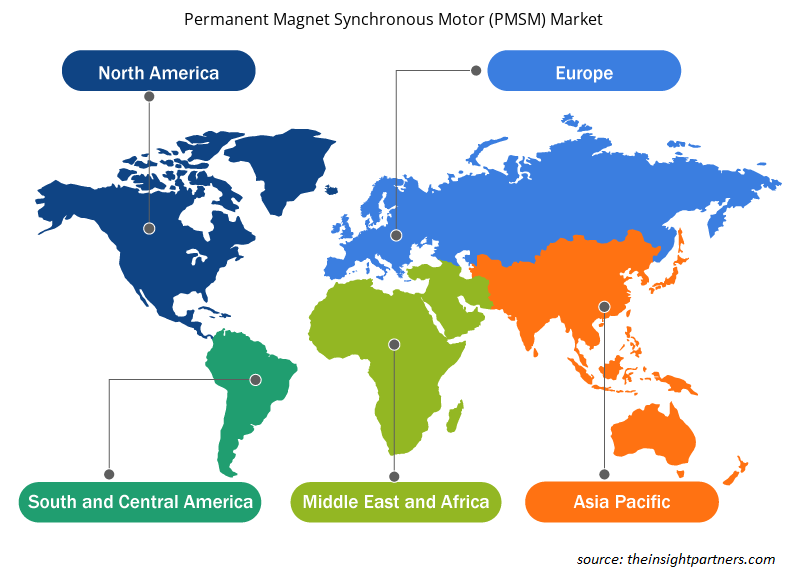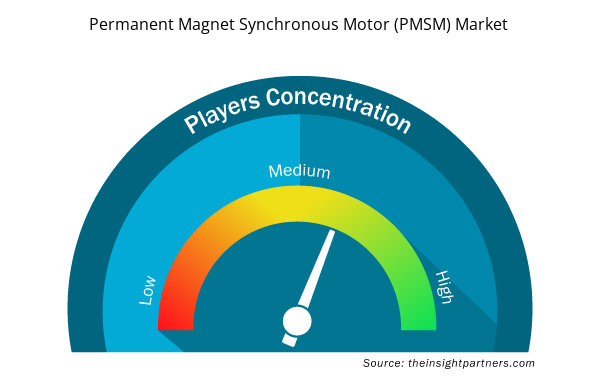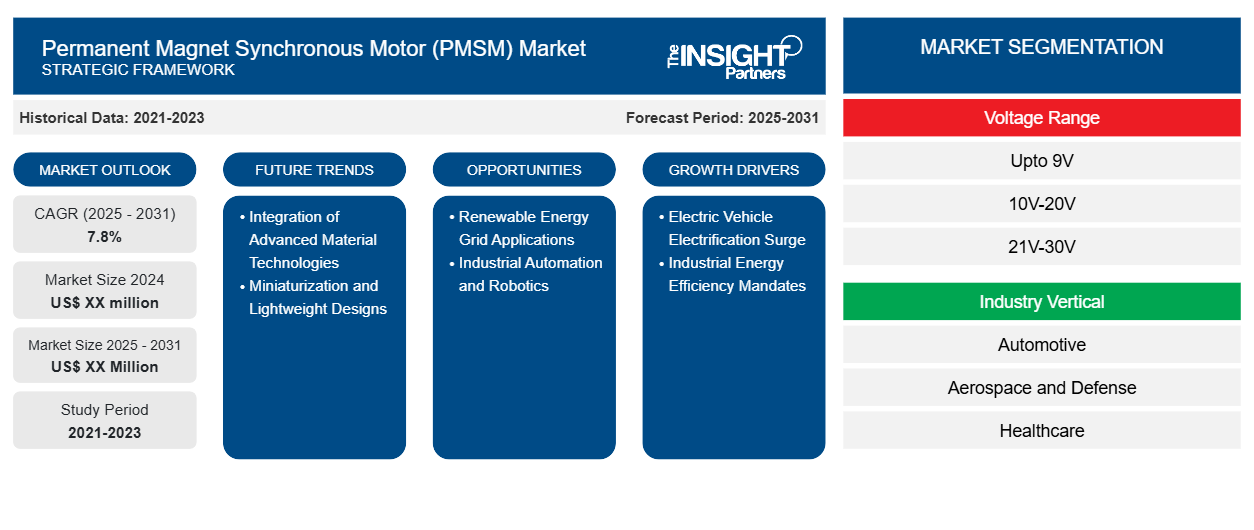Der Markt für Permanentmagnet-Synchronmotoren (PMSM) wird voraussichtlich von 2023 bis 2031 eine durchschnittliche jährliche Wachstumsrate (CAGR) von 7,8 % verzeichnen, wobei die Marktgröße von XX Millionen US-Dollar im Jahr 2023 auf XX Millionen US-Dollar bis 2031 wachsen wird.PMSM) Market is expected to register a CAGR of 7.8% from 2023 to 2031, with a market size expanding from US$ XX million in 2023 to US$ XX Million by 2031.
Der Bericht ist segmentiert nach Spannungsbereich (bis zu 9 V, 10 V–20 V, 21 V–30 V, 31 V–40 V, 41 V–60 V, 60 V und mehr); Branchen (Automobilindustrie, Luft- und Raumfahrt und Verteidigung, Gesundheitswesen, Elektrik und Elektronik, Sonstige). Die globale Analyse ist weiter auf regionaler Ebene und in die wichtigsten Länder unterteilt. Der Bericht bietet den Wert in USD für die oben genannte Analyse und SegmenteUpto 9V, 10V-20V, 21V-30V, 31V-40V, 41V-60V, 60V and above); Industry Vertical (Automotive, Aerospace and Defense, Healthcare, Electrical and Electronics, Others). The global analysis is further broken-down at regional level and major countries. The report offers the value in USD for the above analysis and segments
Zweck des Berichts
Der Bericht „Permanentmagnet-Synchronmotor (PMSM)-Markt“ von The Insight Partners zielt darauf ab, die aktuelle Situation und das zukünftige Wachstum sowie die wichtigsten Antriebsfaktoren, Herausforderungen und Chancen zu beschreiben. Dies wird verschiedenen Geschäftspartnern Einblicke geben, wie zum Beispiel:
- Technologieanbieter/-hersteller: Um die sich entwickelnde Marktdynamik zu verstehen und die potenziellen Wachstumschancen zu kennen, damit sie fundierte strategische Entscheidungen treffen können.
- Investoren: Durchführung einer umfassenden Trendanalyse hinsichtlich der Marktwachstumsrate, der finanziellen Marktprognosen und der Chancen entlang der Wertschöpfungskette.
- Regulierungsbehörden: Zur Regulierung von Richtlinien und Überwachungsaktivitäten auf dem Markt mit dem Ziel, Missbrauch zu minimieren, das Vertrauen der Anleger zu bewahren und die Integrität und Stabilität des Marktes aufrechtzuerhalten.
Marktsegmentierung für Permanentmagnet-Synchronmotoren (PMSM)
Spannungsbereich
- Bis zu 9V
- 10 V bis 20 V
- 21 V bis 30 V
- 31 V bis 40 V
- 41 V bis 60 V
- 60 V und mehr
Branchenvertikale
- Automobilindustrie
- Luft- und Raumfahrt und Verteidigung
- Gesundheitspflege
- Elektrik und Elektronik
- Sonstiges
Passen Sie diesen Bericht Ihren Anforderungen an
Sie erhalten kostenlos individuelle Anpassungen an jedem Bericht, einschließlich Teilen dieses Berichts oder einer Analyse auf Länderebene, eines Excel-Datenpakets sowie tolle Angebote und Rabatte für Start-ups und Universitäten.
- Holen Sie sich die wichtigsten Markttrends aus diesem Bericht.Dieses KOSTENLOSE Beispiel umfasst eine Datenanalyse von Markttrends bis hin zu Schätzungen und Prognosen.
Marktwachstumstreiber für Permanentmagnet-Synchronmotoren (PMSM)
- Aufschwung bei der Elektrifizierung von Elektrofahrzeugen: Der schnelle Übergang der globalen Automobilindustrie zur Elektromobilität ist ein entscheidender Wachstumstreiber für den PMSM-Markt. Strenge Umweltauflagen, sinkende Batteriekosten und eine zunehmende Akzeptanz bei den Verbrauchern beschleunigen die Einführung von Elektrofahrzeugen. Regierungen auf der ganzen Welt setzen aggressive Richtlinien und Anreize zur Förderung des Elektrotransports um, was die Nachfrage nach hocheffizienten PMSM-Technologien in Automobilantriebssystemen direkt ankurbelt.
- Industrielle Energieeffizienz-Vorgaben: Zunehmende industrielle Energieeffizienz-Vorschriften und Nachhaltigkeitsziele zwingen Hersteller dazu, fortschrittlichere Motortechnologien einzusetzen. PMSM bieten im Vergleich zu herkömmlichen Motorkonstruktionen eine überlegene Energieeffizienz bei geringerem Energieverbrauch und reduziertem CO2-Fußabdruck. Regulatorische Rahmenbedingungen wie die Effizienzstandards IE4 und IE5 sorgen für eine starke Marktdynamik für Hochleistungs-Permanentmagnet-Synchronmotoren in der Fertigungs-, HLK- und Prozessindustrie.PMSM offers superior energy efficiency compared to traditional motor designs, with lower energy consumption and reduced carbon footprint. Regulatory frameworks like IE4 and IE5 efficiency standards are creating strong market momentum for high-performance permanent magnet synchronous motors across manufacturing, HVAC, and process industries.
Markttrends für Permanentmagnet-Synchronmotoren (PMSM)
- Integration fortschrittlicher Materialtechnologien: Neue seltenerdfreie und leistungsstarke magnetische Materialien revolutionieren das PMSM-Design. Innovative Verbundwerkstoffe und fortschrittliche Fertigungstechniken ermöglichen effizientere, kompaktere und kostengünstigere Motorkonfigurationen, führen zu Leistungsverbesserungen und verringern die Abhängigkeit von kritischen Rohstofflieferketten.
- Miniaturisierung und Leichtbauweise: Ein weiterer wichtiger Trend auf dem PMSM-Markt ist die Entwicklung kleinerer, leichterer und kompakterer Motorkonstruktionen. Da Industrie und Verbraucher nach platzsparenderen und leichteren Lösungen suchen, konzentrieren sich PMSM-Hersteller auf die Miniaturisierung von Motorkomponenten ohne Einbußen bei Leistung oder Effizienz. Dieser Trend ist besonders relevant für Anwendungen wie Drohnen, Roboter und tragbare Geräte, bei denen eine geringere Größe und ein geringeres Gewicht von entscheidender Bedeutung sind. Darüber hinaus werden miniaturisierte PMSMs zunehmend in Elektrofahrzeugen eingesetzt, wo Platz- und Gewichtseinsparungen zu einer verbesserten Reichweite und Leistung beitragen.
Marktchancen für Permanentmagnet-Synchronmotoren (PMSM)
- Netzanwendungen für erneuerbare Energien: Der Ausbau der Infrastruktur für erneuerbare Energien bietet erhebliches Wachstumspotenzial für PMSM in Windturbinengeneratoren und Energiespeichersystemen im Netzmaßstab. Hohe Effizienz, kompaktes Design und verbesserte Zuverlässigkeit machen diese Motoren für nachhaltige Energieumwandlungs- und -managementtechnologien zunehmend attraktiv.
- Industrielle Automatisierung und Robotik: Die laufende Transformation hin zur Industrie 4.0 schafft erhebliche Marktchancen für präzisionsgefertigte PMSM in fortschrittlicher Robotik, automatisierter Fertigung und anspruchsvollen Bewegungssteuerungssystemen. Die wachsende Nachfrage nach energieeffizienten, leistungsstarken Motorlösungen führt zu einer zunehmenden Akzeptanz in zahlreichen Industriezweigen.
Regionale Einblicke in den Markt für Permanentmagnet-Synchronmotoren (PMSM)
Die regionalen Trends und Faktoren, die den Markt für Permanentmagnet-Synchronmotoren (PMSM) während des gesamten Prognosezeitraums beeinflussen, wurden von den Analysten von Insight Partners ausführlich erläutert. In diesem Abschnitt werden auch die Marktsegmente und die Geografie für Permanentmagnet-Synchronmotoren (PMSM) in Nordamerika, Europa, im asiatisch-pazifischen Raum, im Nahen Osten und Afrika sowie in Süd- und Mittelamerika erörtert.

- Erhalten Sie regionale Daten zum Markt für Permanentmagnet-Synchronmotoren (PMSM)
Umfang des Marktberichts zum Permanentmagnet-Synchronmotor (PMSM)
| Berichtsattribut | Details |
|---|---|
| Marktgröße im Jahr 2023 | XX Millionen US-Dollar |
| Marktgröße bis 2031 | XX Millionen US-Dollar |
| Globale CAGR (2023 - 2031) | 7,8 % |
| Historische Daten | 2021-2022 |
| Prognosezeitraum | 2024–2031 |
| Abgedeckte Segmente | Nach Spannungsbereich
|
| Abgedeckte Regionen und Länder | Nordamerika
|
| Marktführer und wichtige Unternehmensprofile |
|
Marktteilnehmerdichte für Permanentmagnet-Synchronmotoren (PMSM): Auswirkungen auf die Geschäftsdynamik verstehen
Der Markt für Permanentmagnet-Synchronmotoren (PMSM) wächst rasant, angetrieben durch die steigende Endverbrauchernachfrage aufgrund von Faktoren wie sich entwickelnden Verbraucherpräferenzen, technologischen Fortschritten und einem größeren Bewusstsein für die Vorteile des Produkts. Mit steigender Nachfrage erweitern Unternehmen ihr Angebot, entwickeln Innovationen, um die Bedürfnisse der Verbraucher zu erfüllen, und nutzen neue Trends, was das Marktwachstum weiter ankurbelt.
Die Marktteilnehmerdichte bezieht sich auf die Verteilung der Firmen oder Unternehmen, die in einem bestimmten Markt oder einer bestimmten Branche tätig sind. Sie gibt an, wie viele Wettbewerber (Marktteilnehmer) in einem bestimmten Marktraum im Verhältnis zu seiner Größe oder seinem gesamten Marktwert präsent sind.
Die wichtigsten Unternehmen auf dem Markt für Permanentmagnet-Synchronmotoren (PMSM) sind:
- ABB
- Bosch Rexroth AG
- Allgemeine Elektrik
- Hitachi, Ltd
- Johnson Electric Holdings Limited
Haftungsausschluss : Die oben aufgeführten Unternehmen sind nicht in einer bestimmten Reihenfolge aufgeführt.

- Erhalten Sie einen Überblick über die wichtigsten Akteure auf dem Markt für Permanentmagnet-Synchronmotoren (PMSM)
Wichtige Verkaufsargumente
- Umfassende Abdeckung: Der Bericht deckt die Analyse von Produkten, Dienstleistungen, Typen und Endbenutzern des Marktes für Permanentmagnet-Synchronmotoren (PMSM) umfassend ab und bietet einen ganzheitlichen Überblick.
- Expertenanalyse: Der Bericht basiert auf dem umfassenden Verständnis von Branchenexperten und Analysten.
- Aktuelle Informationen: Der Bericht stellt durch die Abdeckung aktueller Informationen und Datentrends Geschäftsrelevanz sicher.
- Anpassungsoptionen: Dieser Bericht kann angepasst werden, um spezifische Kundenanforderungen zu erfüllen und die Geschäftsstrategien optimal anzupassen.
Der Forschungsbericht zum Markt für Permanentmagnet-Synchronmotoren (PMSM) kann daher dabei helfen, die Branchensituation und Wachstumsaussichten zu entschlüsseln und zu verstehen. Obwohl es einige berechtigte Bedenken geben kann, überwiegen die allgemeinen Vorteile dieses Berichts tendenziell die Nachteile.
- Historische Analyse (2 Jahre), Basisjahr, Prognose (7 Jahre) mit CAGR
- PEST- und SWOT-Analyse
- Marktgröße Wert/Volumen – Global, Regional, Land
- Branche und Wettbewerbsumfeld
- Excel-Datensatz



Report Coverage
Revenue forecast, Company Analysis, Industry landscape, Growth factors, and Trends

Segment Covered
This text is related
to segments covered.

Regional Scope
North America, Europe, Asia Pacific, Middle East & Africa, South & Central America

Country Scope
This text is related
to country scope.
Häufig gestellte Fragen
Some of the customization options available based on the request are an additional 3-5 company profiles and country-specific analysis of 3-5 countries of your choice. Customizations are to be requested/discussed before making final order confirmation# as our team would review the same and check the feasibility
The report can be delivered in PDF/PPT format; we can also share excel dataset based on the request
Integration of advanced material technologies is anticipated to play a significant role in the global permanent magnet synchronous motor (PMSM) market in the coming years
Electric vehicle electrification surge and industrial energy efficiency mandates are the major factors driving the permanent magnet synchronous motor (PMSM) market
The Permanent Magnet Synchronous Motor (PMSM) Market is estimated to witness a CAGR of 7.8% from 2023 to 2031
Trends and growth analysis reports related to Electronics and Semiconductor : READ MORE..
1.ABB
2.Bosch Rexroth AG
3.General Electric
4.Hitachi, Ltd
5.Johnson Electric Holdings Limited
6.Leonardo DRS
7.Mitsubishi Electric Corporation
8.Nidec Motor Corporation
9.Siemens AG
10.Toshiba International Corporation
The Insight Partners performs research in 4 major stages: Data Collection & Secondary Research, Primary Research, Data Analysis and Data Triangulation & Final Review.
- Data Collection and Secondary Research:
As a market research and consulting firm operating from a decade, we have published and advised several client across the globe. First step for any study will start with an assessment of currently available data and insights from existing reports. Further, historical and current market information is collected from Investor Presentations, Annual Reports, SEC Filings, etc., and other information related to company’s performance and market positioning are gathered from Paid Databases (Factiva, Hoovers, and Reuters) and various other publications available in public domain.
Several associations trade associates, technical forums, institutes, societies and organization are accessed to gain technical as well as market related insights through their publications such as research papers, blogs and press releases related to the studies are referred to get cues about the market. Further, white papers, journals, magazines, and other news articles published in last 3 years are scrutinized and analyzed to understand the current market trends.
- Primary Research:
The primarily interview analysis comprise of data obtained from industry participants interview and answers to survey questions gathered by in-house primary team.
For primary research, interviews are conducted with industry experts/CEOs/Marketing Managers/VPs/Subject Matter Experts from both demand and supply side to get a 360-degree view of the market. The primary team conducts several interviews based on the complexity of the markets to understand the various market trends and dynamics which makes research more credible and precise.
A typical research interview fulfils the following functions:
- Provides first-hand information on the market size, market trends, growth trends, competitive landscape, and outlook
- Validates and strengthens in-house secondary research findings
- Develops the analysis team’s expertise and market understanding
Primary research involves email interactions and telephone interviews for each market, category, segment, and sub-segment across geographies. The participants who typically take part in such a process include, but are not limited to:
- Industry participants: VPs, business development managers, market intelligence managers and national sales managers
- Outside experts: Valuation experts, research analysts and key opinion leaders specializing in the electronics and semiconductor industry.
Below is the breakup of our primary respondents by company, designation, and region:

Once we receive the confirmation from primary research sources or primary respondents, we finalize the base year market estimation and forecast the data as per the macroeconomic and microeconomic factors assessed during data collection.
- Data Analysis:
Once data is validated through both secondary as well as primary respondents, we finalize the market estimations by hypothesis formulation and factor analysis at regional and country level.
- Macro-Economic Factor Analysis:
We analyse macroeconomic indicators such the gross domestic product (GDP), increase in the demand for goods and services across industries, technological advancement, regional economic growth, governmental policies, the influence of COVID-19, PEST analysis, and other aspects. This analysis aids in setting benchmarks for various nations/regions and approximating market splits. Additionally, the general trend of the aforementioned components aid in determining the market's development possibilities.
- Country Level Data:
Various factors that are especially aligned to the country are taken into account to determine the market size for a certain area and country, including the presence of vendors, such as headquarters and offices, the country's GDP, demand patterns, and industry growth. To comprehend the market dynamics for the nation, a number of growth variables, inhibitors, application areas, and current market trends are researched. The aforementioned elements aid in determining the country's overall market's growth potential.
- Company Profile:
The “Table of Contents” is formulated by listing and analyzing more than 25 - 30 companies operating in the market ecosystem across geographies. However, we profile only 10 companies as a standard practice in our syndicate reports. These 10 companies comprise leading, emerging, and regional players. Nonetheless, our analysis is not restricted to the 10 listed companies, we also analyze other companies present in the market to develop a holistic view and understand the prevailing trends. The “Company Profiles” section in the report covers key facts, business description, products & services, financial information, SWOT analysis, and key developments. The financial information presented is extracted from the annual reports and official documents of the publicly listed companies. Upon collecting the information for the sections of respective companies, we verify them via various primary sources and then compile the data in respective company profiles. The company level information helps us in deriving the base number as well as in forecasting the market size.
- Developing Base Number:
Aggregation of sales statistics (2020-2022) and macro-economic factor, and other secondary and primary research insights are utilized to arrive at base number and related market shares for 2022. The data gaps are identified in this step and relevant market data is analyzed, collected from paid primary interviews or databases. On finalizing the base year market size, forecasts are developed on the basis of macro-economic, industry and market growth factors and company level analysis.
- Data Triangulation and Final Review:
The market findings and base year market size calculations are validated from supply as well as demand side. Demand side validations are based on macro-economic factor analysis and benchmarks for respective regions and countries. In case of supply side validations, revenues of major companies are estimated (in case not available) based on industry benchmark, approximate number of employees, product portfolio, and primary interviews revenues are gathered. Further revenue from target product/service segment is assessed to avoid overshooting of market statistics. In case of heavy deviations between supply and demand side values, all thes steps are repeated to achieve synchronization.
We follow an iterative model, wherein we share our research findings with Subject Matter Experts (SME’s) and Key Opinion Leaders (KOLs) until consensus view of the market is not formulated – this model negates any drastic deviation in the opinions of experts. Only validated and universally acceptable research findings are quoted in our reports.
We have important check points that we use to validate our research findings – which we call – data triangulation, where we validate the information, we generate from secondary sources with primary interviews and then we re-validate with our internal data bases and Subject matter experts. This comprehensive model enables us to deliver high quality, reliable data in shortest possible time.


 Holen Sie sich ein kostenloses Muster für diesen Bericht
Holen Sie sich ein kostenloses Muster für diesen Bericht